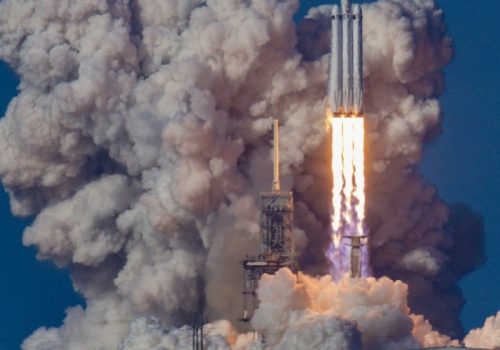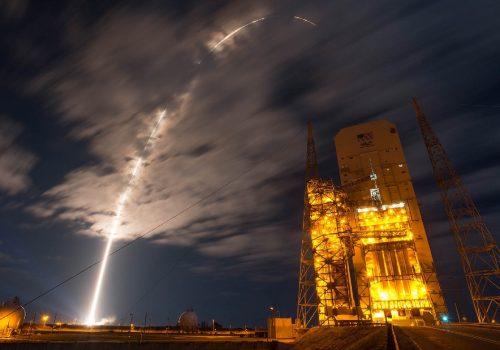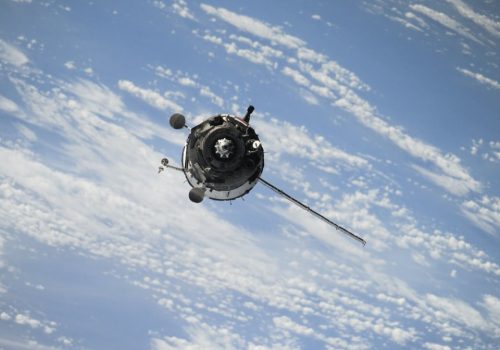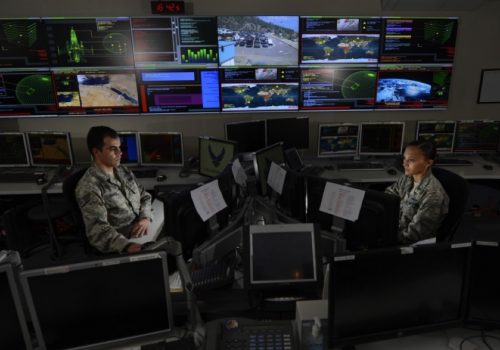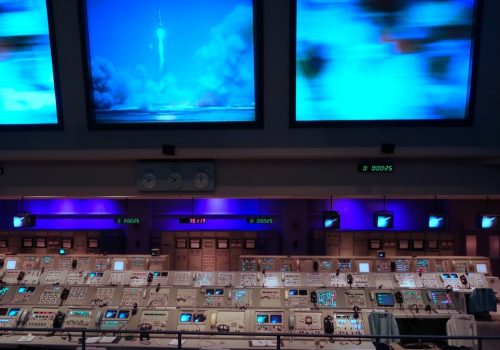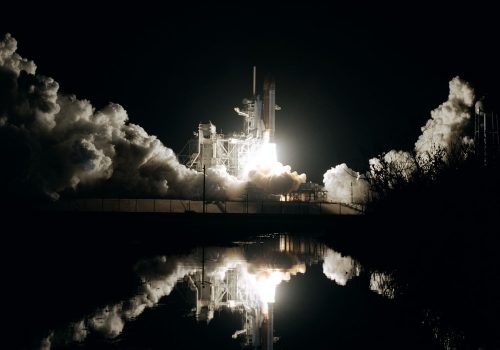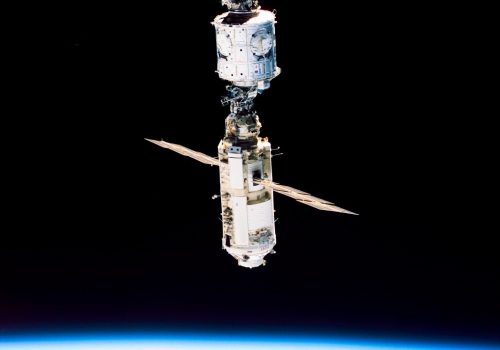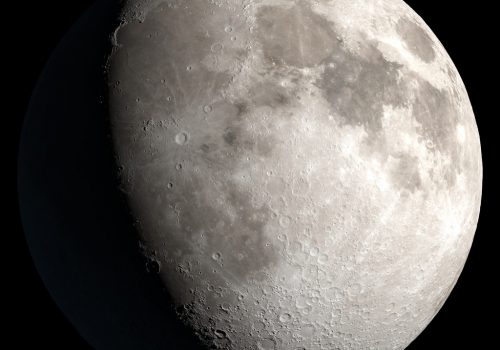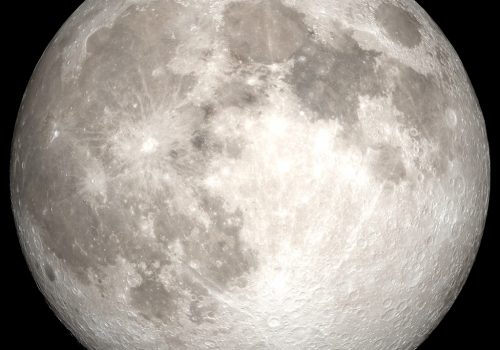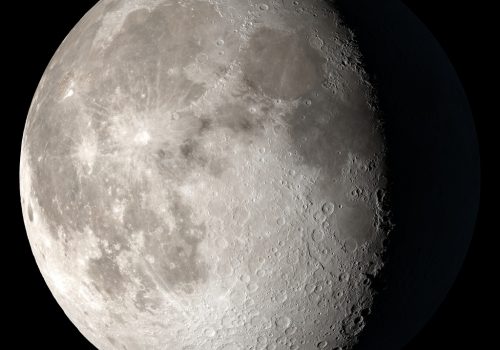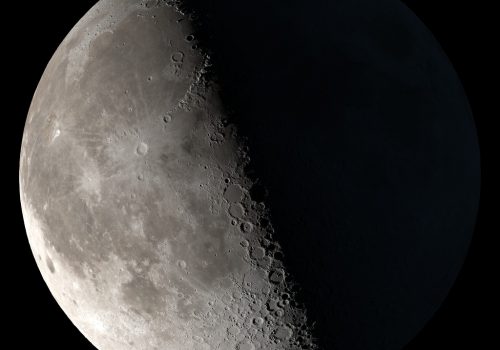April 11, 2021
The future of security in space: A thirty-year US strategy
Key takeaways
- Space development has reached an inflection point, transitioning from a phase of discovery to phases of security and commerce.
- Spacefaring countries and companies are harnessing new technologies to push new boundaries, uncovering value while simultaneously opening the door to chaos and competition.
- The United States and its allies and partners must take action over the next three decades to secure a future of security and prosperity.
A new vision for space
Watch our launch event
Table of contents
Foreword
Executive summary
I. Strategic context
II. Key goals for US security strategy in space
III. Major elements of the strategy
IV. Guidelines for implementation
V. Conclusion
There will come an age in the far-off years when Ocean shall unloose the bonds of things, when the whole broad earth shall be revealed, when Tethys shall disclose new worlds and Thule not be the limit of the lands.
Foreword
Some national strategies are designed to endure for a few years, a single administration at most—but such an approach will not suffice for outer space.
Security and prosperity in space are too important to life on Earth, and too sensitive to long-term trends, to address with short-term strategies. The security of assets in space will have a defining impact on future terrestrial conflicts. Economic prosperity on Earth increasingly depends on data transmitted through space. Even more so than many domains on Earth, security and prosperity in space depend on long-term technology developments. That is why the authors of this strategy paper call for the United States, in concert with its allies and partners, to implement a thirty-year strategy for space.
The ambitions of this strategy paper are bold enough to merit such a timeframe. The authors call for an overhaul of the body of international law governing space. They make a compelling case to replace the 1967 Outer Space Treaty with a new, foundational space treaty that addresses the security and commercial realities of space in the twenty-first century. The authors call for a new coalition of the willing to push back on recent destabilizing Russian and Chinese activities in space. New alliances—and existing ones—need to step up their commitments to security in outer space. An attack in outer space could have devastating consequences on Earth, and no ally should be left without support because existing treaties do not yet fully recognize the consequences of space attacks. Finally, the legal, security, and physical architectures that the United States develops over the coming decades must explore opportunities for the commercial sector to plug in, or even take over, elements. Not only will commercial firms be crucial to developing the technologies that will define space activity, but there will also, by 2050, be a range of profit-making activities in space that one can only begin to imagine today. The United States can develop plans for space now in a way that enables it to benefit later.
Crucially, the authors of this strategy paper take on two developments in space that require deep thinking now because of their impact in coming decades. First, this paper considers point-to-point transportation around the Earth transiting space. As space-launch costs continue to plummet, the military is already conceiving the use of space ports for thirty-minute transportation to any point on Earth. Clever commercial applications will be only a few years behind. Work must begin on legal and diplomatic frameworks now. Second, this strategy explores the development of the Lagrange points—orbits in the Earth-Sun and Earth-Moon systems with advantageous, stable gravitational attraction. Space agencies already understand the benefits of placing satellites at these points. Will these become chokepoints over which spacefaring nations battle, or oases of future space commerce? This strategy suggests that the United States must work for the latter, while being prepared for the former.
The bold, forward-looking recommendations of this strategy call for the kind of long-term thinking and practical actions that the United States needs today if it is to secure the commanding heights of security and prosperity a generation hence. Our hope is that space, foreign policy, and national security policy makers are inspired to act based on this landmark strategy paper. We are.

General James E. Cartwright, USMC (ret.)
Eighth Vice Chairman, Joint Chiefs of Staff
Board Director, Atlantic Council

Secretary Deborah Lee James
Twenty-Third Secretary, United States Air Force
Board Director, Atlantic Council
Executive summary
Across cultures, centuries, and continents, exploration has been core to the human experience. For the United States, where crucial advances in astronomy, rocketry, and space exploration took place, its identity as a spacefaring nation is ingrained in its history, society, and self-image. As Ed Weiler, the Hubble Space Telescope’s first chief scientist, said some thirty years ago, “The universe is even more complex than we dream. Almost everywhere we look, we find something bizarre.”
Today, activity in space seems an unremarkable part of daily life, but the possibility for space to further transform and inspire society is as great as the headiest days of the 1960s space race. Many questions remain unanswered about the future of space development, but space remains critical for global security and prosperity and will become even more so in the decades and centuries to come. Conducted over the course of a year, this Atlantic Council Strategy Paper provides an ambitious thirty-year strategy for the United States, alongside its allies and partners, to harness today’s innovation, shape the future trajectory of space activity and discovery, and secure this evolving domain to ensure future prosperity so that humankind can exponentially reap its benefits.
Figure 1: The increasing congestion of Earth orbits, 1975 vs. 2019
Since the launch of the first satellite in 1957, space has grown congested with more and smaller satellites being launched into Earth orbits. Limited space situational awareness and insufficient space traffic management risk satellite collisions, which could generate space debris endangering the use of these orbits.
Slide to see the increased congestion of objects orbiting Earth (left) and expansion of development further from Earth’s surface (right) from 1975 to 2019.
Images: NASA
Four developments defining the future of space
Four major developments together provide both an opportunity and a requirement for the United States and its allies and partners to define the future of space activity and adopt a long-term space strategy. These are:

The boundless potential of space for humankind
Increased reliance on space for human activity. For the United States, its allies and partners, spacefaring nations, and humanity at large, space holds the potential to revolutionize Earth’s economy, security, and, potentially, the nature of human civilization itself. Outer space has, for decades, been a vital resource—one that both enables security and prosperity on Earth and is rapidly becoming the locus of an increasingly large share of humankind’s economy. Space enables critical economic and security activities on Earth. The global economy depends on communications, navigation, timing, and remote sensing that occur in space—the US economy more so than any other. For the United States, space is also essential for national security missions, including launching intercontinental ballistic missiles, detecting and tracking missile launches, communicating securely with forces deployed across the globe, and observing otherwise-denied areas.
A promise of radical abundance and resilience. Recognizing the known and unknown values of space to humankind means that this still-relatively-new domain will increase in importance in the coming decades and centuries. Humankind still has much to discover in this vastly unknown frontier and enabling further exploration will uncover resources integral to the resilient existence of life on Earth. Space holds virtually unlimited sources of energy, vast amounts of useful materials, and untapped potential to provide a “radical abundance” of resources for humankind in the future. These developments could lead to “radical resilience” for societies, or generally position humanity to better respond to challenges, like climate change, on Earth. Space has been invaluable for producing wealth, spurring commerce, and winning wars for decades—but a qualitatively different aspect to space is emerging today and may be primary in thirty years’ time. This new paradigm for space prioritizes the security and economic activities that occur within space itself, not just those they enable on Earth.

Space is on the cusp of a major transition from exploration to security and commerce
The phased development of space. Space is no longer the exclusive domain of scientific exploration and discovery. As with all new domains, space is undergoing a transition from one phase to another which raises new questions about the ways activity in space will be defined in the future and who will define it. Space is transitioning from a phase of “discovery” to phases of “security” and “commerce.” These next phases will be defined by an explosion of commercial activity and security operations necessary to protect that activity, safeguard access and maneuverability, prevent malign actions, and pave the way for more routinized space activity. The time is rapidly approaching when space’s value to security on Earth will be matched by the need to secure the economic activity occurring within Earth orbit. Even as commercial concerns begin to dominate Earth orbit in the short term, over the next thirty years, the frontier of economic activity in space will likely expand to encompass cislunar space, the spherical area formed by the radius between the Earth and the Moon. To bridge this phased transition in space, the United States, in concert with its allies and partners, must set forth a framework to protect sovereignty and property in space.
An explosion of space actors. Unlike the 1960s space race, space is no longer a domain in which few nation-states operate. Over the past several decades, there has been an explosion of actors with activities and interests in space that will continue to define its trajectory. While the United States still leads in space by many measures, including its share of global space investments and numbers of satellites in orbit, there are a far greater number of countries operating in space today. Russia, China, the European Union, Japan, and India have all deployed their own global or regional satellite navigation networks comparable to the US Global Positioning System (GPS). A legion of smaller national players—from Luxembourg to New Zealand to the United Arab Emirates—are playing in the arenas of space commerce, exploration, and security. Multipolarity in space presents a range of challenges and opportunities for the United States to achieve security and prosperity in space.
Figure 2: An explosion of nations in space
Space has seen a proliferation of actors since nations first began launching space-related agencies and programs in the mid-1950s
Commerce as a driver of activity. Nation-states are far from the only entities operating in space. Corporations have been making money in Earth orbit for half a century and will continue to lead innovation in space, creating opportunities and challenges for governments. New technology and business revolutions—in microelectronics, telecommunications, and space launch—have made a compelling business case for commercial firms to conduct missions in low Earth orbit (LEO) that had traditionally been situated in geosynchronous Earth orbit (GEO). The result of this trend—massive constellations of small satellites—will upend the commercial space business and transform the global communication industry. Indeed, while traditional advances in defense technologies (like ballistic missiles) have driven space commerce and exploration in the past, it is increasingly commercial developments (like on-orbit satellite servicing) that are driving defense capabilities and concerns going forward.

Security in space is at risk, and the United States must act urgently
The security (ad)vantage point of space. From a security perspective, there is an urgent need for the United States and its allies and partners to shape the future trajectory of space. In many ways, space is the ultimate “high ground,” as it contains key “terrain” that is very advantageous for surveillance, warfighting, and rapidly expanding commercial uses. This high ground is becoming more and more useful for nations—including the United States and its allies and partners, as well as competitors like China and Russia. Securing this high ground over the coming decades is imperative for spacefaring nations to gain and maintain an advantageous position.
The return of great-power competition. Increased competition among the United States, China, and Russia on Earth further complicates the security picture in space. Great-power competitors may find themselves in a struggle for space resources and this high ground. The winners of this struggle will likely be those nations that can establish a generally accepted space framework, which is why the United States must urgently seek to shape this framework. How nations interact; develop space capabilities; and advance future tactical, operational, and strategic plans will shape the future trajectory of space. If great-power competitors are unable to agree on key space norms, rules, and frameworks, a long-term struggle for space superiority may escalate into tension and potentially even boil over into warfare. The authors of this report lay out a strategic plan to not only prevent a space catastrophe from occurring, but to encourage dialogue and planning to unlock new opportunities and innovation. The United States should lead now to shape the rules of the road for space and ensure favorable frameworks are developed and adhered to, otherwise these rules will be written for it. To realize this potential, it is imperative that policymakers act now and in accordance with a long-term strategy.
Risk of disruption and denial of space activity and access. Since the 1990s, the United States’ expeditionary model of warfare has relied on space capabilities for both tactical and strategic intelligence, missile-launch warning, and communication. Meanwhile, China and Russia are fielding increasingly sophisticated counterspace weapons capable of disrupting, denying, or destroying US and allied space assets in conflict or crisis. The saliency of denying space access is likely to increase in great-power competition. The vulnerability of space systems to lower-cost cyberattack means that other, smaller competitors could also achieve counterspace effects. The creation of the Russian Aerospace Forces (2015), the Chinese People’s Liberation Army Strategic Support Force (2015), and the US Space Force (2019) all point to competitors perceiving space as a warfighting domain.

New frontiers of exploration require shaping
The edge of humanity’s routine activity in space is moving beyond GEO to encompass cislunar space, the sphere formed by the Earth-Moon radius. This opens new opportunities and risks that any future strategy must come to grips with. As the United States continues to plan a crewed lunar landing in the 2020s, commercial firms are racing to support exploration efforts (and even resource extraction) on the Moon. At the Lagrange points—areas of particular orbital stability in the Earth-Moon system—nation-states are deploying satellites for research and, increasingly, military reconnaissance. The Lagrange points (and other advantageous orbital regions) may become contested as nations seek to observe and operate in cislunar space, and activity there will become all the more important in the coming decades.
Strategic approach
These developments—today and through 2050—demand a new US approach to space. This Atlantic Council Strategy Paper offers space, foreign policy, and national security policymakers a roadmap for navigating this new space age.
Space is in desperate need of a long-term strategy
Given the pace of major trends, a short-term strategy for space is insufficient. While the 2020 US National Space Policy and 2018 US National Space Strategy helpfully identified principles, goals, and guidelines for US space activity, a longer-term lens is needed. This strategy does not profess to predict or anticipate all changes that may occur in space over the next three decades, but its ambitious timeframe is deliberate to raise questions and encourage the long-term strategic vision necessary. It is imperative for the United States and its allies to get out ahead and shape the future of space in ways favorable to them. This paper proposes the United States takes a phased approach to implementing a long-term strategy, including milestones in the short, medium, and long term to achieve security and prosperity in space and on Earth (enabled by space). Thinking strategically will help shape the context in which novel technologies and activities are introduced, even if specific technological advancements are largely unpredictable in the thirty-year time horizon. Any strategy that is implemented should be updated over time and will require regular reevaluation of goals and policies. The United States, in concert with its allies and partners, has the opportunity now to shape the future of space over the next thirty years if it takes action today.
The importance of allies and partners
Realizing the full potential of space requires that the United States work with many spacefaring nations, including existing allies and new partners, and in some instances with competitors. This strategy seeks to set forth a future for space that is free, secure, and prosperous. But, this strategy prepares for the eventuality that some nation-states may harbor malignant intent. It will be critical to monitor the space strategy and policy of US competitors—which are sure to evolve in the timeframe of this strategy—to determine where cooperation is possible and where competition is necessary.
The strategy
Vision and strategic goals
The vision of this strategy is to ensure the space domain remains harmonious, fully accessible, organized, and regulated. This will allow humankind to reap the benefits of space resources in perpetuity. The key goals of this strategy are to:
- promote stability, harmony, and freedoms among space actors by establishing a rules-based order for space;
- deter hostile action and secure US and allied space assets, access to, and freedom of navigation within the global commons of space; and
- foster US and global prosperity through the continued expansion of space commerce.
A blueprint for securing space by 2050
This strategy paper provides the following blueprint for the United States and its allies and partners to take to secure space in the long term. It includes the following four steps, each of which is elaborated below:
- provide guidelines for space governance, laying out “rules of the road” for safe and secure operations in space;
- defend space access from those nation-states—particularly great-power competitors—which would seek to deny it;
- accelerate space commerce critical for space development through clear regulation and targeted investments; and
- intentionally push the envelope of security and commercial activity to embrace cislunar space—the area between the Earth and the Moon.
Principal recommendations
To accomplish these goals, the strategy recommends graduated actions to be taken in the short (2021-2025), medium (2025-2040), and long (2040-2050) term. Over the three-decade time period, this strategy calls for the United States to:
1. Update and refine the legal and regulatory frameworks governing space.
The international law of space, centered on the 1967 Outer Space Treaty, is outdated and insufficient for a future of space in which economic activity is primary. The international community needs a new foundational space treaty, and the United States should precipitate its negotiation. Moreover, the United States needs to update its domestic governance of space, such as ensuring that each administration uses the National Space Council, an executive body to coordinate government-wide space activity, as well as empowering the council to deliver a thirty-year strategy for space.
i. In the short term, the US president should appoint, and the State Department should staff, the office of a special presidential envoy for space. The US special presidential envoy for space should then energize the United Nations Office for Outer Space Affairs to socialize norms for responsible space behavior, which should include US allies, competitors, and industry in laying a foundation for a comprehensive space order.
ii. In the short term, the United States should also reform space administration. The Biden administration should form a National Space Council immediately, ideally chaired by the vice president, which should be charged with developing and overseeing the implementation and regular reevaluation of a thirty-year space strategy. The administration and Congress should collaborate on legislation to ensure each administration utilizes and staffs the National Space Council. The Congress should monitor the newly formed US Space Force and, in due time, mandate a study of whether an independent Department of the Space Force is warranted.
iii. In the medium term, the United States should lead the international community in either extending the International Civil Aviation Organization (ICAO) area of responsibility to space or creating an ICAO-like organization for space activity. Doing so can begin laying the foundations for customary international law favorable to security and prosperity in space prior to replacing the 1967 accord. Even in the long term, international space governance must remain flexible to an evolving space domain in which development will be ever changing.
iv. In the long term, spacefaring nations should construct a modern, internationally agreed-upon order and “rules of the road” for behavior in space. Advancing space technology is outpacing existing rules, and the absence of space law invites excessive uncertainty and instability. The following steps should be taken prior to establishing a new space treaty.
2. Establish a collective security alliance for space.
To deter aggression in space, the United States should form a new space security alliance, including likeminded spacefaring nations, to establish collective security in space.
i. In the short term, the United States should engage its existing allies in discussions to gain common understandings of space security and take part in coordinated allied activities in space and space-adjacent capabilities to enhance allied credibility on space security.
ii. In the medium term, the United States can activate existing alliances to build international consensus on the protection of space-related assets and develop a shared understanding of the importance of defending key resources and access and the need for an alliance to establish collective security in space.
iii. In the long term, the United States should lead the establishment of a space security alliance.
3. Accelerate space commerce through clear regulation and targeted investment.
The United States should identify and invest in keystone space technologies—those capabilities with positive externalities to the entire space industrial base. In doing so, the United States and likeminded governments can accelerate private-sector use of Earth orbit in the short term, while developing cislunar space toward the end of the thirty-year period.
i. In the short term, through public-private partnerships, and by leveraging its considerable research-and-development budget, the US government should promote the development of keystone space technologies. Those technologies enable a range of missions in space at affordable cost in the short term, including technologies for launch, communications, and in-situ resource utilization (ISRU).
ii. In the medium term, the United States should involve allied and US subnational governments and leadership in space organization and infrastructure. At a federal level, the government should provide grants and other incentives to encourage state, local, tribal, and territorial governments to participate in the space economy through research grants for state universities, the lease of state public lands for space ports, and building infrastructure for space launch. This may be a valuable way to increase revenue streams for remote localities, leading to increased local prosperity. Further, the United States should work to negotiate access to space ports in foreign countries.
iii. In the medium term, an appropriately utilized and staffed National Space Council at the Cabinet level can avoid redundant commercial regulation across executive agencies. The National Space Council should incorporate industry perspectives in a structural fashion.
iv. In the long term, enhancing private-public partnerships in space will enable the United States to maintain and expand its technological edge in space, including in the crucial area of diversifying space launch platforms and employing ISRU on the Moon and beyond.
4. Take a cislunar approach to space development.
This strategy seeks to expand nations’ access first to Earth’s orbit and eventually to cislunar space, which together will host an increasingly large fraction of the global economy over the next thirty years. This cislunar approach to space will involve the routinization of space activity in cislunar space over the next thirty years, to an extent similar to how activity in LEO is unremarkable today.
i. In the short term, US exploration of the Moon and Mars via the Artemis program provides a number of avenues for increasing security uses of cislunar space.
ii. In the medium term, as commercial activity in Earth orbit becomes ever more routine, US civil and military entities should push the envelope of regular space activity into cislunar space, the area between the edge of where most current satellites orbit and the Moon, and similarly advantageous areas identified in the solar system.
iii. In the long term, the United States should seek to build infrastructure at the Lagrange points, critical strategic geography within cislunar space, in service of a “Cislunar Economy” that will eventually rival today’s “LEO Economy.” Given China’s planned activities on the Moon—including the planned establishment of a permanent base on the water-rich lunar south pole—increased attention in this region of space is crucial.
I. Strategic context
Space in 2050 will look vastly different from space today. Over the next decade alone, the number of satellites could quintuple as government and industry entities launch various missions. While such proliferation of activity will enhance space-based capabilities, enabling universal Internet access, and enhancing Earth-observation and data-collection capabilities, it also risks further space debris triggering an unstoppable chain of collisions. Space is currently undergoing a paradigm shift, as commercial entities are developing and fielding the technologies that are the key drivers of space utilization. Indeed, inventive space companies are expanding the concept of what is possible in space, eyeing space tourism in the near future, and simultaneously growing the space economy to what could be a trillion-dollar enterprise by 2040. In the long term, commercial and state entities will see novel levels of cislunar activity, requiring ISRU and onsite, three-dimensional (3D) manufacturing to keep pace with space activity. Indeed, spaceflight could underpin resiliency on Earth, opening access to space-based energy and material resources. Yet, with the realization of such value in the space domain, the future may see an increased use of space by militaries, including great-power competitors China and Russia. China is racing to develop capacity for its own permanent space station, cislunar supremacy, and deep-space exploration within the next thirty years. Despite the expansive future of space, the current space framework is rooted in the past. The future is just around the corner, and protecting space will cultivate innovation, wealth, and security to the benefit of all humanity.
To achieve security and prosperity in space—just as in any domain—national efforts must progress through three phases:
Today, space, and Earth’s orbit specifically, is on the cusp of transitioning from phase two to phase three, with commercial entities eager to leverage space for private business ends. Within thirty years, the frontier of space commercialization will likely expand from the edge of GEO to cislunar space. However, with the regulation and security of space not yet well established, the world risks a new Wild West or Scramble for Space.
Generally, this bold strategy for space assumes that the future strategic environment will be distinct, and in ways unpredictably so, from the present strategic environment. Specifically, this strategy assumes that the primary driver for space security will be space commerce, that strong alliances will prove just as relevant (or even more relevant) to space activity as to Earth-based activity, and that the strategic geography of space—key access points and orbits—will be become even more critical and contested. This strategy paper attempts to identify primary areas that need improved norms, regulation, and laws. It is impossible to identify all issues in space that will emerge over the next three decades. However, the positions, offices, and bodies that this strategy paper proposes will be well positioned to take on these challenges in due time.
Routinization of Earth orbit
Rather than being exceptional, it is becoming routine that major countries find that their national security and economic interests extend to space. Indeed, the days are numbered that Earth orbit will be considered more a part of outer space than an integral part of Earth’s economic, political, and social structures. Because activity in Earth orbit is becoming so routine, and is proceeding at an increasing pace, questions of space sustainability and the consequences of debris in Earth orbit are coming to the fore.
Small- and medium-sized countries are fielding research, intelligence, and communications assets in Earth orbit. Major powers are gearing up their militaries to increase space situational awareness, defend their space assets, and exercise space control. Smaller countries are betting the future of their economies on space commerce. Commercial entities are preparing to develop entirely new lines of business in orbit. The simultaneous increase in the space economy and the degrading space security environment may touch off a “space rush.”
The space rush of the 2020s differs from the space race of the 1950s and 1960s, when the United States and the Soviet Union dominated space exploration and development. Today, more than eighty national space programs around the globe have entered the space rush, contributing to space advancements while increasing space congestion. Spacefaring nations, along with non-state space entities, are partaking in the competition to seize upon vast opportunities ranging from commercial wealth to military dominance.
Who controls low-earth orbit controls near-Earth space. Who controls near-Earth space dominates Terra. Who dominates Terra determines the destiny of humankind.
Great-power competition
Competition among the great powers—the United States, China, and Russia—is the defining feature of international security on Earth as it is in space.
More states in space
Paraguay, New Zealand, Luxembourg, and the United Arab Emirates offer four examples of how governments are seizing upon emerging opportunities.
Space sustainability
Satellites are critical for security and prosperity, but they are also delicate, expensive hardware subject to damage in the harsh environment of space by small pieces of debris. Because objects in space travel so fast, a bus-sized satellite can be destroyed by an object the size of a marble and critically damaged by a fleck of paint. This vulnerability makes space debris of vital importance. Due to a range of factors—the proliferation of smaller satellites in LEO, counterspace weapons tests, and collisions in space—the amount of space debris has become extensive.
Space-surveillance networks regularly track and catalogue more than twenty-eight thousand debris objects.
There exists a tipping point where the quantity of debris is great enough that entire orbital bands become unusable. In 1978, NASA scientist Donald J. Kessler proposed a theory that debris-driven collisions can become self-perpetuating, making space access impossible. This runaway effect is known as the “Kessler Syndrome.” As the density of objects in LEO increases, so does the number of collisions, producing more debris fragments. The larger number of debris fragments subsequently increases the number of collisions, producing yet more debris in a vicious cycle.
To protect operating satellites and preserve space sustainability, space situational awareness (SSA) and space traffic management (STM) are vital missions. While these two areas have some overlap, they have notable differences, and should be addressed separately.
In sum, commerce and security activity in Earth’s orbit are an unexceptional part of the global economy and international relations. This routinization has consequences for the space environment and threatens to significantly interfere with satellite operations in the coming decades. Plenty of pressing issues remain in Earth orbit, among them the evolution of commercial and defense technology, the role of the private sector, and access to critical materials for space systems. But, beyond Earth orbit, a thirty-year strategy needs to consider the next frontier—cislunar space.
The promise of cislunar space
Human economic and security activity in the space domain is already beginning to extend beyond Earth orbit and will, within the timeframe of this strategy, encompass cislunar space. The sphere created by the Earth-Moon radius, cislunar space offers the chance to extend activities beyond GEO, with the possibility of scientific and military observation, military sensing and communication, and resource extraction. Cislunar space is particularly attractive, as it offers three elements essential to human space activity: energy, materials, and integrated intelligence. Without these three convergent streams, space-mission success is obstructed. Cislunar space provides all three of these assets simultaneously, and is positioned relatively close to the Earth. With Earth only about 1.35 light seconds from the Moon, cislunar space offers a platform wherein Earth-based communications can control missions in real time. Additionally, because the Moon sits in a shallow gravity well compared to Earth, space vehicles can more easily propel from points in cislunar space. Thus, cislunar space offers a viable point for kickstarting exploration beyond Earth orbit.
Within the vast expanse of cislunar space, there is important strategic geography that could become areas of tension, including the Earth-Moon Lagrange points.
What are Lagrange points?
The Earth-Moon Lagrange points are the gateways of cislunar space. Lagrange points are regions in space where the gravitational forces of two celestial bodies (such as the Sun and the Earth or the Moon and the Earth) produce regions of enhanced orbital stability. These points are already attracting scientific missions and will likely host security and economic activity as phases of space development evolve. Even as initial deployments to the Lagrange points take place, spacefaring entities are building on an unstable scaffolding. The Lagrange points are unregulated and present the risk of a tragedy of the commons should government or commercial activity accelerate before a regulatory framework is established.
The security of Lagrange points will be essential to maintaining and expanding US and allied interests in space. Putting a spacecraft at (or in a “halo” orbit around) a Lagrange point allows it to stay in a fixed position relative to a celestial body. Thus, spacecraft placed at Lagrange points consume far less station-keeping fuel, reducing costs and enhancing longevity. There are five Lagrange points numbered L1 through L5 in any orbital system, and, while there are plenty of uses of the Earth-Sun system, this paper concerns itself with the Earth-Moon Lagrange points. Lagrange points are a vital piece of space “real estate”; although space is large, a hostile power could dominate a Lagrange point and exclude other nations from accessing it.
Today, exotic orbits like these are consigned to the pages of astrophysics journals and conferences. But, in decades’ time, they could be the front-page concern of defense analysts and national security policymakers. Today, satellite placement in GEO is tightly regulated by the International Telecommunications Union (ITU), a United Nations (UN) specialized agency, so that satellites in GEO do not interfere with each other. Without future regulation, specialized orbits in cislunar space may suffer from a tragedy of the commons where individual satellite operators have no incentive to deconflict with each other.
Figure 3
Image credit: NASA
While Earth orbit and cislunar space will be the critical theaters of space strategy, two cross-cutting issues will impact the development of these space domains: the employment of emerging technology in space applications and the increasing role of the private sector in space activity.
Commercial and defense technology
The strategic space environment will be shaped by emerging technology developments, which enable more sophisticated satellite networks, enhance Earth observation, and reduce costs while effectively broadening access to space. These technologies will enable a range of new commercial and military space missions and applications.
The space environment is characterized by increasingly capable kinetic and non-kinetic anti-satellite weapons. With the expanding value of space, these weapons will become increasingly salient as the threat of space conflict grows.
Anti-satellite weapons (ASATs)
The United States began testing direct-ascent anti-satellite weapons (DA-ASATs) in 1959, eventually destroying a solar observation satellite in 1985 with the ASM-135 missile. DA-ASATs have ground-to-space capabilities, with a terrestrial launch that targets space-based infrastructure. Currently, the United States possesses several ballistic-missile-defense (BMD) interceptors, which function as latent kinetic ASATs. These BMD systems include the Ground-Based Midcourse Defense (GMD), the Aegis-based SM-3, and the Terminal High Altitude Area Defense (THAAD). While these systems are designed as BMD, any exoatmospheric BMD has an inherent, latent ASAT capability. Indeed, the technical requirements for hitting a satellite are no more challenging than hitting a missile so a nation with strong missile-defense prowess can be said to have an ASAT capability. However, as of now, the United States has prioritized DA-ASATs to a lesser extent than China or Russia, and arms-control proposals by those nations reflect that. Proposals such as the Treaty on Prevention of the Placement of Weapons in Outer Space and of the Threat or Use of Force Against Outer Space Objects (PPWT), pushed by China and Russia, focus on space-to-space or space-to-ground weapons placed in space; this notably excludes ground-to-space weapons like DA-ASAT capabilities.
In 1968, the Soviet Union successfully demonstrated an anti-satellite weapon. In 2018, a Russian MiG-31 fighter jet was photographed with a possible air-launched ASAT. Russia’s S-400 surface-to-air missile system can range to LEO satellites but may not be accurate enough to target them. In 2007, China conducted its first successful kinetic ASAT test, destroying an aging Chinese meteorological satellite with an SC-19 missile. This test, which came with no warning and produced a dangerous quantity of debris, violated international norms and brought China widespread criticism. China has not conducted any additional debris-producing ASAT testing since, but intelligence analysts believe that China has conducted several non-impact related kinetic trajectory tests, which could reach GEO satellites, with its DN-2 and DN-3 interceptors. In 2019, India became the fourth country to successfully test a kinetic ASAT weapon, which was employed against a small target satellite in LEO over the Bay of Bengal. While India is a promising partner of the United States, US officials condemned this test for potentially endangering the International Space Station. Other nations such as North Korea and Iran have continued to expand their ballistic-missile programs.
While direct-ascent kinetic ASATs are of concern, both Russia and China are experimenting with co-orbital ASATs and non-kinetic orbital assets to compromise or destroy US and allied satellites. A co-orbital ASAT is an object that, stationed in orbit, can change its orbit rapidly and collide with or otherwise disable (e.g., with a robotic arm) another satellite. Unlike ground-to-space DA-ASAT technologies, co-orbital ASATs are space to space, with satellites targeting other objects in orbit.
Non-kinetic weapons
In addition to kinetic ASATs, various countries have developed counterspace cyber capabilities. The cyber threat to space assets ranges from theft or alteration of information to destruction of satellites or their supporting components. Cyberattacks directly target data and data systems, exploiting links between satellites and from satellites to ground stations. Since cyberattacks are less likely to produce debris when rendering a satellite inoperable, they may function as a “soft-kill” capability. As such, nations may perceive cyberattacks on space assets as less escalatory and therefore view cyberweapons as more usable than debris-producing hard-kill alternatives.
Directed-energy weapons (DEWs) pose an increasingly viable threat to space-based assets. Directed-energy weapons primarily operate by blinding, jamming, or damaging sensors or circuits, rendering a satellite inoperable. DEWs operate at different thresholds—they can dazzle (temporarily blinding the optical sensor of a satellite), disable (rendering the satellite itself temporarily inoperable), or destroy (permanently destroying the satellite itself), with varying energy requirements across that spectrum. Directed-energy threats include lasers, high-power microwaves, and other types of radiofrequency weapons. Through fake transmissions or spoofing, radiofrequency weapons can interrupt satellite connections and, thus, achieve similar ends as do cyber means.
Electronic warfare (EW) will present a major and evolving threat to space-based positioning, navigation, and timing (PNT) assets and the Global Navigation Satellite Systems (GNSS) in the timeframe of this strategy. EW includes radiofrequency (RF) jamming and GPS spoofing. These techniques have been used in terrestrial warfare for decades, so it is no surprise that this practice is expanding to space. One space-distinct EW application is uplink and downlink jamming. Although usually temporary, jamming technology has the ability to seriously inhibit or block various space-based technologies on which modern economies and global militaries rely, such as GPS, satellite communications (SATCOM), and SAR imaging.
Private-sector engagement
While private firms have been making money in space for more than fifty years, the lion’s share of commercial activity in space has been about enabling activity on Earth—including transmission of radio and television signals and Earth observation. These activities remain important and have enormous potential for growth in the coming decades. Yet, there is a new wave of space commerce coming that implicates activity within space—mining, manufacturing, and tourism. This new category of space commerce has the potential to move the space domain into a commercial phase distinct from the scientific and security concerns that have previously dominated. As this transition occurs, the United States will have to interact with the private sector—already a crucial element of space strategy—in a different manner to foster discovery and innovation, while guarding against exploitation that could prove detrimental to sustainable space development.
The private sector is, and will remain, a key element in the success of US and allied space programs. Especially since NASA ended the Space Shuttle program, space programs have relied less on governments and more on private industry, as evidenced by the burgeoning US commercial space industry. A decade after the first commercial launch of a satellite to LEO in 2009, the space industry has accelerated, with more than $25.7 billion of private investment globally. Despite this importance, private-sector space entities sometimes face challenges in interacting with the US government. These obstacles include a complex regulatory and compliance environment that can be slow moving, risk averse, and process based, rather than outcome oriented.
II. Key goals for US security strategy in space
Currently, given the widespread reliance on space for a variety of civilian and military applications, space is increasingly “competitive, congested, and contested.” In the coming thirty years, the United States and likeminded nations should nurture a thriving, self-sustaining economy in space. Further, as the space domain transitions away from a phase of development primarily characterized by exploration, the United States must lead in establishing a security order that enables this space economy and pushes the envelope of human economic activity beyond GEO and into cislunar space. To do so, the United States, in concert with its allies and partners, should work to provide the common goods of sovereignty and property rights in space. Accordingly, this long-term space strategy prioritizes the following three goals: build an international rules-based order for space; deter hostile action and secure space assets and access; and foster US and global prosperity through the continued expansion of space commerce.
III. Major elements of the strategy
Earth orbit is on the edge of a transition from being primarily the remit of exploration and security to being the locus of a thriving economy. In the next thirty years, human economic and security activity is likely to push this envelope further, embracing cislunar space. This transition must be built upon a solid regulatory, security, technological framework, and human capital base.
In order to achieve a rules-based order in space, preserve the US and allied space security advantage, and advance technology for space development, the United States—in coordination with its allies and partners—should prioritize new space law, a new space security alliance, advanced space technology, and a cislunar approach to space as the major elements of US national strategy for space over the next thirty years.

Update and refine the legal and regulatory framework governing space
Major spacefaring entities are increasingly disregarding the existing space treaties or interpreting them in increasingly expansive ways to justify their activities in space. In the long term (2040-2050), the United States should seek to develop a new, foundational space treaty. Because international agreements of this sort can take years, if not decades, to negotiate, in the short term (2021-2025), the United States should seek to develop customary international law that matches US and allied norms for space and to forge consensus among likeminded nations about the need to develop a new treaty on the international law of space.
The United States begins socializing key elements of a new space treaty to set the scene for diplomatic negotiations.
US government negotiates bilateral and multilateral agreements similar to the 2015 SPACE Act to influence the development of international space law.
The United States achieves buy-in from likeminded nations on core principles of space exploration, security, and commerce.
US and allied governments decide to extend the ICAO area of responsibility or create an ICAO-like organization to monitor space activity.
US and likeminded governments align orbital-debris mitigation standards.
The United States works to create a formalized system to exchange SSA within the international community.
The United States seeks widespread accession to a new, foundational treaty for outer space activity.
Purpose of a new foundational space treaty
• Guarantee freedom of navigation and exploration in space. Freedom of navigation can be accomplished only through expeditionary space security; limited weaponization in space and the extension of military intelligence, surveillance, and reconnaissance (ISR); and civilian and military communications infrastructure and capabilities throughout outer space, in planetary orbits, and on celestial bodies.
• Continue the Outer Space Treaty’s provisions that prohibit the placement or use of nuclear weapons or other weapons of mass destruction in space. As such, even a future international legal framework that loosens restrictions on conventional weapons in space should preserve nonproliferation of nuclear weapons and weapons of mass destruction (WMD). The objective from the 1967 treaty of preserving inclusivity and peaceful uses of space should be cemented as well. However, this legal framework must remain pragmatic to the requirement of space security and defense of peaceful use and access from malign actors.
• Address space sustainability. To do so, the treaty should contain provisions that account for orbital-debris mitigation and removal. Indeed, the need for this provision is likely to increase dramatically by 2050 as the pace of space launch only increases and protection of Earth’s biosphere requires further attention.
• Contain the same ideal of non-appropriation of entire celestial bodies as in the 1967 Treaty (that prohibits the establishment of sovereignty over the Moon or any other celestial bodies), but it ought to be clarified so as not to interfere with the placement of peaceful installations on these bodies or prohibit resource extraction. Moreover, the 1967 treaty was correct to rule out appropriation of celestial bodies, but this new treaty must go further by prohibiting the seizure and exclusion of important orbital zones, such as the Lagrange points, while allowing for legitimate safety zones.

Establish a space security alliance
The United States and its allies must create a framework for cooperation and mutual security in space by forming an international space security alliance and extending the reach of existing alliances like NATO—appropriate for the twenty-first century and beyond—to ensure collective security and deter aggression in space. As described earlier in the paper, over the next thirty years great-power competition is likely to impact activity in space, and space may well be used by the United States’ strategic competitors to achieve broader security goals on Earth. As space activity increases, Earth-based activities enabled by space will multiply over time, and space-based activities will have greater potential impact on security on Earth itself. As a result, the securitization of space will become an increasingly important focus, and the establishment and maintenance of collective security among likeminded nations will be important in the long term (2040-2050). To reach this, in the short (2021-2025) and medium terms (2025-2040), the United States should focus on arriving at common understandings of space security with allies and partners and on engaging in coordinated activities in space.
United States prioritizes a common understanding of the space security environment and builds capacity.
The United States comes to common understandings with allies and partners about mutual interests in space.
United States works with NATO and likeminded partners to develop an ambitious set of aligned activities for cooperation in space.
The United States undertakes multilateral and bilateral diplomatic efforts with European and Indo-Pacific allies and partners to socialize the need for a space alliance in the long term.
The United States, its existing allies, and new partners commit themselves to a space security Alliance which pledges collective security and mutual defense from attacks in the space domain.
Purpose of a space security alliance
This space security alliance should promote cooperation among allies and partners, and establish and guarantee collective security. A key first task for the alliance will be to devise a tailored strategy, building on this thirty-year strategy for space, to counter hostile action and guarantee safe access and passage, free from malign interference, in space. A space security alliance should deter countries known to be undermining collective access and security in space—or those nations that have actions in, and goals for, space that are not entirely known. This strategy must be flexible enough to keep up with rapidly advancing technology and establish rules of the road for conduct and cooperation in space, deterring adversarial action that jeopardizes the space commons. While the United States and its allies will always reserve the right to defend themselves, they must identify ways to extend their long history of working with competitors when appropriate. Even competitors of the United States recognize that the space domain is so dynamic, diverse, critical to advancing humanity, and interconnected that one entity could not possibly act alone to secure space.
In the years ahead, the United States and its allies and partners will need to walk a difficult line between all-out competition with near-peers like China and Russia, and cooperation on issues including addressing the climate crisis, reforming the world health system in the wake of COVID-19, and realigning international trade. Enhanced cooperation in space—whether it be research, dealing with space debris, or deconflicting satellite orbits—may be one avenue to improving overall relations. While it is foolish to think of space exclusively as a domain of peaceful cooperation, it is equally unhelpful to emphasize only competition in space.

Facilitate the business of space technology
To facilitate the transition to an orbital economy in the long term (2040-2050) and maximize space-based services to Earth in the short term (2021-2025), the US government should invest in space launch, satellite-constellation operations, upgraded space power and propellants, on-orbit services, and ISRU; prepare for rocket transportation; develop innovative ways of harnessing the private sector; and secure supply chains critical to the manufacture of space components. It is difficult, if not impossible, to predict which technologies will be critical in thirty years’ time. To account for the nonlinear nature of technological development, this strategy recommends investing in some specific technologies to push the envelope of space development in the short term and engaging in reforms to government practices that will encourage the development of space technology throughout the thirty-year timeframe of this strategy.
The United States increases national investment in research and development, specifically to ensure emerging space developments are leveraged for US and allied interests.
US government reviews existing acquisition policies and regulations that hinder public-private cooperation and space technology advancement.
US officials carefully monitor critical supply chains for critical space components.
US government undertakes efforts to regulate rocket launch and build landing infrastructure.
The United States works with key allies and partners, notably in Europe and Asia, to build space ports in allied countries.
The national security space community reevaluates which technologies should be prioritized for investment in coordination with industry and academia.
The United States and its allies develop disaggregated, multidomain, and mobile launch platforms.
Figure 4

Take a cislunar approach to space
To achieve long-term security and prosperity in space, the United States should emphasize the development of cislunar space, the sphere formed by the Earth-Moon radius.
While the Lagrange points offer one attractive orbit in cislunar space that is obvious to strategists in 2020, there is a potential for other orbital “real estate” in cislunar space to become contested over the next thirty years. Furthermore, similarly advantageous zones of the solar system may be reached, and their potential realized, in the coming decades. For example, the moons of planets like Mars, Jupiter, and Saturn, and other bodies in space, such as the planetoid Ceres and asteroids, provide fertile ground for mining operations. Securing cislunar space will provide a critical trial in protecting these valuable zones for sustainable space exploration. By working to wisely and proactively manage the Lagrange points, the United States can set the international standard for constructive resolution of future debates in cislunar space and beyond.
NASA evaluates the Artemis program and adjusts benchmarks for its space exploration program if needed, prioritizing a deep-space exploration program.
The United States considers the implications of military satellites and SSA for the routinization of cislunar space.
NASA develops infrastructure at the Lagrange points while US diplomats negotiate an international framework to regulate the use of cislunar space.
The United States and likeminded nations build out a presence at the Lagrange points to eventually transition to commercial operators.
IV. Guidelines for implementation
In pursuit of the goals of this strategy, US policymakers should coordinate with allies and partners to execute the major elements of this strategy using the following guidelines for implementation. Policymakers must weigh these recommendations with potential drawbacks and alternatives.
Photos: NASA
Strategy timeline
To be effectively executed, this strategy for space security suggests several specific policy initiatives that can be considered and pursued within the next thirty years. The below list summarizes the policy recommendations and proposed timelines.
In the short term (2021 – 2025)
- The president should appoint, and the Department of State should staff, a special presidential envoy for space to socialize norms of responsible space behavior with likeminded nations.
- The special presidential envoy to space should address the uncontrolled region between flight level 600 and the Kármán line.
- US diplomats and policymakers should engage existing allies, in forums like NATO, about the need for coordinated activity in space.
- The president should direct the National Space Council to create, and regularly reexamine, a long-term plan to develop a space security alliance.
- NASA should evaluate the ambitious timeline of the Artemis program to determine if it is realistic and, if needed, adjust benchmarks for its deep-space exploration program.
- The Department of Defense should invest in keystone technologies and seize future opportunities to bolster, incentivize, and minimize restrictions on collaboration with the private sector, working with start-up ventures and innovative firms when practicable.
- The Department of Defense should increase funding for defense science and technology and basic research.
- NASA should work with the national laboratories to ensure a steady supply of satellite-grade nuclear material and include nuclear propulsion in its public-education programming.
- To avoid redundancy across agency regulations, the president should include in the National Space Council a body representing industry, such as the Users’ Advisory Group.
- The president should staff the National Space Council at the Cabinet level, chaired by the vice president, and the US Congress should draft legislation to make this body permanent.
- CISA should evaluate whether space should be designated as a critical infrastructure sector.
- Congress should continue to monitor the US Space Force and review space-related procurement processes.
- The US federal government should incentivize subnational governments to review and draft legislation for space infrastructure and provide space-related state-university research grants.
- The US federal government should seek continued improvements in SSA capabilities, funding initiatives such as the Space Fence that improve the Space Surveillance Network, particularly as it relates to smaller objects.
- The US Department of Defense should seek collaborative partnerships with foreign nations to obtain higher-quality SSA data, particularly tapping into geographic advantages that allies in the Eastern Hemisphere can offer.
- The US federal government should work on a collaborative database for the fusing of SSA data, improving on the steps initiated by the creation of CSpoC. This database should involve a lower level of classification than current data provided.
- Under the guidance of the National Space Council, authorities over SSA and STM should be transferred to a civil agency such as the Department of Commerce, developing an open-architecture SSA repository with an extensive public catalog of SSA data.
In the medium term (2025 – 2040)
- The special presidential envoy for space should achieve buy-in from likeminded nations on core principles of space exploration, security, and commerce to set the ground for a new comprehensive space treaty.
- The State Department should transition the US special presidential envoy for space to an ambassador at large.
- US and allied policymakers should review existing space treaties, such as the Moon Treaty and the Space Liability Convention, and incorporate viable components into a new space treaty.
- The US and likeminded governments should synchronize domestic policies in constructing a framework for orbital-debris mitigation.
- US government should work with NATO to prioritize a common understanding of space security and develop an ambitious set of aligned activity for space operations.
- The Department of Defense should consider the implications of military satellites and space situational awareness on the routinization of cislunar space.
- The United States, along with its allies and partners, should expand EW countermeasures to protect growing space assets against adversarial weapon systems.
- The US Congress should consider authorizing a commission to evaluate whether an independent Department of the Space Force is warranted.
- The special presidential envoy for space should achieve buy-in from likeminded nations on norms and standard operating procedures that allow for common access to new resources for ISRU activity.
- The US government should build out rocket-transportation infrastructure and regulate point-to-point launch for commercial and military purposes, eventually coordinating international regulations and constructing space ports with global partners.
- The US Departments of Commerce and State should consult with relevant commercial entities on a set of best-practice guidelines for STM, working to develop bottom-up guidelines that can then be brought to the international community.
In the long term (2040 – 2050)
- The United States and likeminded nations should sign a foundational space treaty that recognizes the transforming nature of the domain and protects a growing future of space commerce.
- The United States, its existing allies, and new partners should commit themselves to a space security alliance that pledges collective security and defense from attacks in the space domain, with clear rules for membership, funding, dispute resolution, and obligations.
- NASA should develop infrastructure at the Lagrange points, while US diplomats seek to negotiate an international framework to regulate use of these points among other valuable cislunar real estate.
- US space agencies should invest in, and sustain, a “culture of education,” especially in STEM fields, with a heavy focus on artificial intelligence, robotics, and quantum-related technologies, to name just a few specialized disciplines.
- The United States should seize the mantle of international leader on STM norms, capitalizing on what is likely to be an increase in market share in the commercial space sector. This will give the United States leverage to shape the rules and norms for STM. In coordination with allies and partners, the United States should extend its SSA and STM efforts to cislunar space.
V. Conclusion
I have always found that plans are useless, but planning is indispensable.
For centuries, humankind has gazed up at the cosmos pondering life, yet humans only reached this final frontier mere decades ago. Since human arrival in space, the realm of possibility has drastically expanded to incorporate new spacefaring nations and companies, new inventions, and new orbits. One can only imagine the infinite value and potential that space will offer in the decades ahead. As we grapple with existential challenges on Earth, we may continue to look to space to derive potential answers. While a thirty-year US strategy cannot begin to imagine the unimaginable, a long-term vision is critical to advance the position of spacefaring nations and shape the future trajectory of this critical high ground.
Over the next thirty years, space security will continue to evolve as legal frameworks and alliances are developed, technologies advance, and investments in public-private partnerships are made. In order for the United States to protect a promising future of space prosperity, it must work with likeminded nations to: enhance a rules-based international order for space, preserve US and allied leadership in space, strengthen US and allied technological advantages in space, and push space development to cislunar space. In the absence of concerted action, humankind risks diminishing the immense value still being discovered in Earth orbit and beyond.
There are significant first-mover advantages that accrue to the leader of this new “space rush.” The United States can set the new do-no-harm standards for conduct in space like resource extraction and access to the Lagrange points. While the United States must be sober in its assessment of the importance of space in great-power competition, it should seek peaceful exploration and cooperation with all spacefaring countries—including China and Russia—where possible. In the interest of global security on Earth and within space, the United States must work with its allies and partners to normalize rules of conduct and engagement and deter against aggression in the space domain. In the timeframe of this strategy, commerce in Earth orbit will become routine, normal, and unremarkable, constituting an increasingly large share of global economic activity. Still, this development faces serious threats. Through new space governance, a new space security alliance, and new space technology, the United States can realize that vision while pushing humanity’s economic frontier into cislunar space.
The United States is not just a nation that uses space; it is a spacefaring nation. Space exploration, value, and security are tightly woven into the collective US psyche, not to mention the US scientific, commercial, and military establishments. Russian rocketeer Konstantin Tsiolkovsky famously stated that “the Earth is the cradle of the mind, but one cannot eternally live in a cradle.” It is time for the United States to fully enmesh Earth orbit in legal, security, and commercial apparatuses so that space exploration agencies can focus on cislunar space, Mars, and the boundless universe beyond.
In essence, this strategy is laid out with the understanding that “plans are useless, but planning is indispensable.” Determining what will and will not be the reality in 2050 is a futile exercise, as benchmarks laid for the next decade may be eclipsed by great and unknown achievements in the coming years. However, paving a roadmap to 2050 is helpful in shaping the goals, policies, and investments necessary to pursue enduring prosperity and security in space tomorrow. Keeping the future at the forefront, regardless of developments that may materialize and on what timeline, situates humankind to reap the benefits of space activity in perpetuity.
Lead authors
Related analysis
Subscribe for updates
Sign up for updates from Forward Defense to hear the latest on the trends, technologies, and military challenges shaping tomorrow.
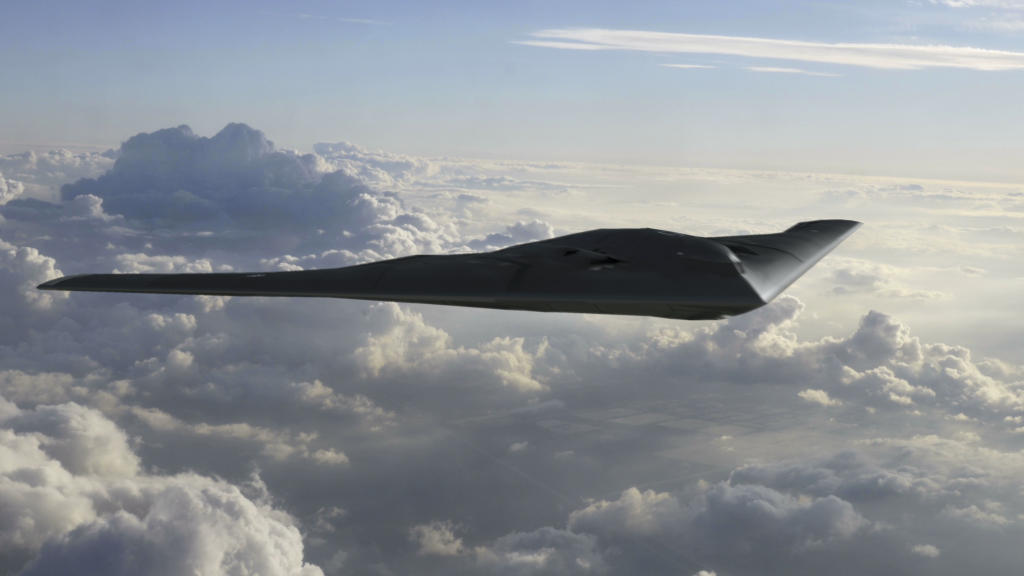

Forward Defense, housed within the Scowcroft Center for Strategy and Security, generates ideas and connects stakeholders in the defense ecosystem to promote an enduring military advantage for the United States, its allies, and partners. Our work identifies the defense strategies, capabilities, and resources the United States needs to deter and, if necessary, prevail in future conflict.


The Scowcroft Center for Strategy and Security works to develop sustainable, nonpartisan strategies to address the most important security challenges facing the United States and the world.
Icon Acknowledgments1“Space Holds Boundless Potential for Humankind”: Icon made by Pixelmeetup from www.flaticon.com; “Space is on the Cusp of a Major Transition”: Icon made by Good Ware from www.flaticon.com; “Security in Space is at Risk, and the United States Must Act Urgently”: Icon made by Freepik from www.flaticon.com; “New Frontiers of Exploration Require Shaping”: Icon made by Freepik from www.flaticon.com; “Update and Refine the Legal and Regulatory Framework Governing Space”: Icon made by Freepik from www.flaticon.com; “Establish a Space Security Alliance”: Icon made by Freepik from www.flaticon.com; “Accelerate Space Commerce through Clear Regulation and Targeted Investment”: Icon made by dDara from www.flaticon.com; “Take a Cislunar Approach to Space”: Icon by Icongeek26 from www.flaticon.com.
Image: Cover credit: Helen Lundeberg, “The Veil,” 1947, The Macfarlane Collection


